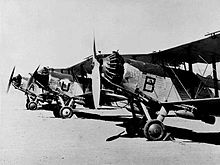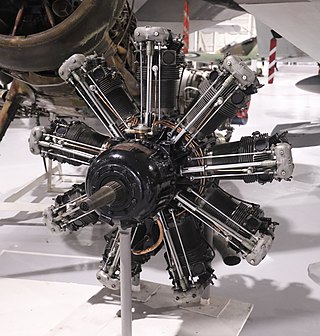
The Bristol Jupiter is a British nine-cylinder single-row piston radial engine that was built by the Bristol Aeroplane Company. Originally designed late in World War I and known as the Cosmos Jupiter, a lengthy series of upgrades and developments turned it into one of the finest engines of its era.

The Fairey Fox was a British light bomber and fighter biplane of the 1920s and 1930s. It was originally produced in Britain for the RAF, but continued in production and use in Belgium long after it was retired in Britain.

The Bristol Bulldog is a British Royal Air Force single-seat biplane fighter designed during the 1920s by the Bristol Aeroplane Company. More than 400 Bulldogs were produced for the RAF and overseas customers, and it was one of the most famous aircraft used by the RAF during the inter-war period.

The Hawker Hart is a British two-seater biplane light bomber aircraft that saw service with the Royal Air Force (RAF). It was designed during the 1920s by Sydney Camm and manufactured by Hawker Aircraft. The Hart was a prominent British aircraft in the inter-war period, but was obsolete and already side-lined for newer monoplane aircraft designs by the start of the Second World War, playing only minor roles in the conflict before being retired.

The Boulton Paul P.29 Sidestrand was a twin-engine biplane medium bomber of the Royal Air Force. Designed for daylight operations, it was manoeuvrable and provided with three defensive gun positions. Named after a village on the Norfolk coast near Boulton & Paul's factory in Norwich, the Sidestrand first flew in 1926 and entered service in 1928. It remained in service until 1936, equipping No. 101 Squadron RAF. It was an agile and relatively fast aircraft that was capable of aerobatic manoeuvres such as loops, rolls and spins.
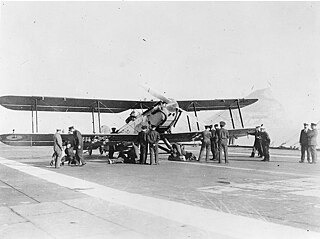
The Fairey Aviation Company Fairey III was a family of British reconnaissance biplanes that enjoyed a very long production and service history in both landplane and seaplane variants. First flying on 14 September 1917, examples were still in use during the Second World War.

The Vickers Type 131 Valiant was a British general-purpose biplane produced by Vickers in 1927, with the intention of replacing the Royal Air Force's Airco DH.9As, but was unsuccessful, with only a single example built, which was sold to Chile.

The Vickers Vildebeest and the similar Vickers Vincent are single-engined British biplanes designed and built by Vickers and used as light bombers, torpedo bombers and in army cooperation roles. First flown in 1928, they remained in service at the start of the Second World War, with the last Vildebeests flying against Japanese forces over Singapore and Java in 1942.

The Handley Page Heyford was a twin-engine biplane bomber designed and produced by the British aircraft manufacturer Handley Page. It holds the distinction of being the last biplane heavy bomber to be operated by the Royal Air Force (RAF).

The Handley Page Hinaidi was one of two twin-engine bombers built by Handley Page that served with the Royal Air Force between 1925 and 1935. The aircraft was developed from the Handley Page Hyderabad and named after Hinaidi, an RAF station in Iraq.

The Hawker Horsley was a British single-engined biplane bomber of the 1920s. It was the last all-wooden aircraft built by Hawker Aircraft, and served as a medium day bomber and torpedo bomber with Britain's Royal Air Force between 1926 and 1935, as well as the navies of Greece and Denmark.
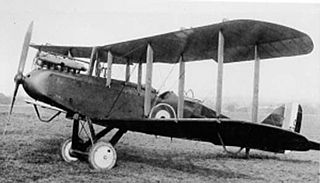
The Airco DH.9 – also known after 1920 as the de Havilland DH.9 – is a British single-engined biplane bomber that was developed and deployed during the First World War.

The Westland Walrus was a British spotter/reconnaissance aircraft built by Westland Aircraft.

The Avro 549 Aldershot was a British single-engined heavy bomber aircraft built by Avro.
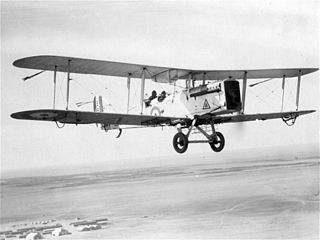
The Airco DH.9A is a British single-engined light bomber that was designed and first used shortly before the end of the First World War. It was a development of the unsuccessful Airco DH.9 bomber, featuring a strengthened structure and, crucially, replacing the under-powered and unreliable inline 6-cylinder Siddeley Puma engine of the DH.9 with the American V-12 Liberty engine.

The Westland Wallace was a British two-seat, general-purpose biplane of the Royal Air Force, developed by Westland as a follow-on to their successful Wapiti. As the last of the interwar general purpose biplanes, it was used by a number of frontline and Auxiliary Air Force Squadrons. Although the pace of aeronautical development caused its rapid replacement in frontline service, its useful life was extended into the Second World War with many being converted into target tugs and wireless trainers. In 1933 a Westland Wallace became the first aircraft to fly over Everest, as part of the Houston-Mount Everest Flight Expedition.
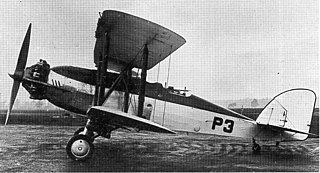
The Westland PV-3 was a British two-seat torpedo bomber of the 1930s built by Westland Aircraft Works. The aircraft was a private venture development and based on the Westland Wapiti. It never entered production. The aircraft is best known as one of the first two to fly over Everest as part of the Houston-Mount Everest Flight Expedition.

The Airco DH.10 Amiens was a twin-engined heavy bomber designed and produced by the British aircraft manufacturer Airco. It performed the first nighttime air mail service in the world on 14-15 May 1919.

The Armstrong Whitworth Atlas was a British single-engine biplane designed and built by Armstrong Whitworth Aircraft. It served as an army co-operation aircraft for the Royal Air Force (RAF) in the 1920s and 1930s. It was the first purpose-designed aircraft of the army co-operation type to serve with the RAF.

The Fairey Fawn was a British single-engine light bomber of the 1920s. It was designed as a replacement for the Airco DH.9A and served with the Royal Air Force between 1924 and 1929.

